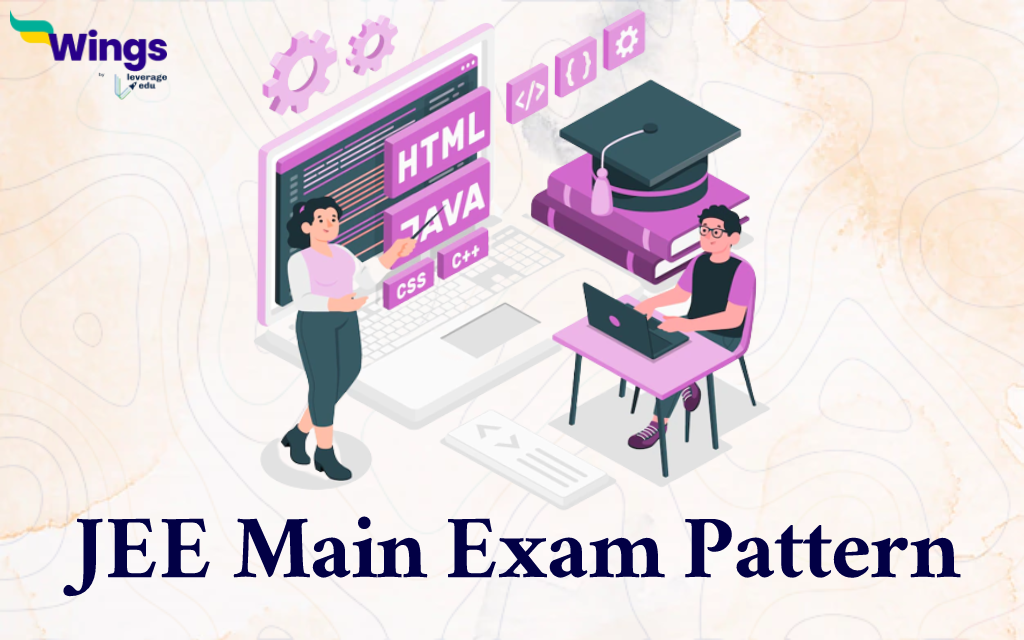JEE Main Exam Pattern: The JEE Mains is an entrance-level national exam for students who want to pursue engineering. The exam is conducted by the National Testing Agency (NTA). When it comes to do preparation for the Joint Entrance Exam, candidates should have knowledge about the latest JEE Main exam pattern including the marking system and subject-wise weightage.
On the basis of their JEE score students can get admission to engineering courses offered by IIT, IIIT, NIT and other government-funded technical institutes. If you are preparing to appear in this exam then you should read this full blog to know the exam pattern that is followed in the JEE Mains exam.
| Particulars | JEE Main Paper 1 | JEE Main Paper 2 |
| Subject | B.E./B.Tech | B.Arch and B.Planning |
| Mode of examination | Computed Based Test | Computed Based Test;Pen and paper-based for Drawing section in B.Arch |
| Duration | 3 hours | (3.5 hours for both – B.Arch and B. Planning) |
| Total Marks | 300 marks, | 400 marks |
| Total Questions Asked | 90 questions | B.Arch – 82 questions;B.Planning- 105 |
Contents
JEE Mains Exam Pattern 2023
Knowledge of key JEE exam patterns is essential for candidates and students taking the IIT JEE exam. Candidates who closely observe and follow JEE’s main examination patterns are not only able to develop successful study plans but are ultimately more likely to perform well and achieve better scores on entrance examinations.
Must Read: JEE Main Slot Booking
The students must be aware that for every correct answer, they will receive 4 marks but for every incorrect answer -1 mark will be deducted. The JEE Mains consists of two papers. The exam pattern layout is given below:
Paper 1: B.E/B.Tech
| Subject | Section A (MCQs) | Section B (Numerical Value) | Marks | |
| Number of Questions in paper | Number of Questions in paper | Number of questions can be attempted | ||
| Physics | 20 | 10 | 5 | 100 |
| Chemistry | 20 | 10 | 5 | 100 |
| Maths | 20 | 10 | 5 | 100 |
| Total | 90 Questions | 75 Questions are mandatory to attempt | 300 |
Paper 2A: BArch
| Subject | Section A (MCQs) | Section B (Numerical Value) | Marks | ||
| Number of Questions in paper | Number of questions that can be attempted | Number of Questions in paper | Number of questions can be attempted | ||
| Maths | 30 | 20 | 10 | 5 | 100 |
| Aptitude | 50 | 20 | 0 | 0 | 200 |
| Drawing | 2 | 20 | 0 | 0 | 100 |
| Total | 82 Question | 77 Questions are mandatory to attempt | 400 |
Paper 2B: B.planning
| Subject | Section A (MCQs) | Section B (Numerical Value) | Marks | ||
| Number of Questions in paper | Number of questions to be attempted | Number of Questions in paper | Number of questions to be attempted | ||
| Maths | 30 | 20 | 10 | 5 | 100 |
| Aptitude | 50 | 20 | 0 | 0 | 200 |
| Planning Based | 25 | 20 | 0 | 0 | 100 |
| Total | 105 Question | 100 Questions are mandatory to attempt | 400 |
The JEE main exam pattern specifies how the exam is administered and how the JEE main exam papers are determined.
JEE Main Exam Paper 1 consists of 90 questions. Candidates only need to answer 25 questions from each section for a total of 75 questions. The remaining five questions are from Section B of all three subjects. For JEE Main Paper 2A (B.Arch), the candidate receives 82 questions and attempts only 77 questions. For the B.Plan paper, the exam consists of 105 questions and the candidate is required to answer only 100 questions. They can leave 5 questions from the Mathematics (numerical section).
Important Points of Exam Pattern
According to the National Testing Agency (NTA), students will get two chances to improve their exam scores if they did not perform their best on their first try. The first attempt gives the student first-hand experience of taking the exam, allowing them to know their mistakes and correct them on the second attempt. This reduces the chance of missing a year, and the dropper doesn’t have to waste their year as well.
If a candidate misses an exam for some unavoidable reason (such as an officer’s exam), they don’t have to wait a full year. Candidates are not required to attend both sessions. However, if candidates appear in the session, their JEE Main 2023 NTA scores will be considered for the merit list/ranking.
FAQs
JEE Main Paper 1 will be conducted with computer support only. Similarly, parts 1 and 2 of part 2 (mathematics and aptitude tests) are conducted in computer-based mode, while part 3, which includes the drawing test, is conducted in pen-and-paper mode. both online and offline. Candidates cannot choose to take the exam online or offline.
For B.Tech, JEE Main has three sections: Mathematics, Chemistry, and Physics. For B.Arch, JEE Main has three sections: Math, Aptitude, and Drawing Test.
Students can choose from 13 different languages for their exam. The languages are, English, Hindi, Assamese, Kannada, Bengali, Marathi, Malayalam, Odia, Tamil, Punjabi, Telugu, Gujarati and Urdu.
In this blog, we discussed the JEE Mains Exam pattern. Students who are willing to participate in this entrance exam can find all the information about exam patterns. It will help the students to prepare well for their exam.
For more such updates stay tuned to our Indian exams page. And don’t forget to follow us on Instagram, Facebook, Twitter, and Linkedin.
 One app for all your study abroad needs
One app for all your study abroad needs














